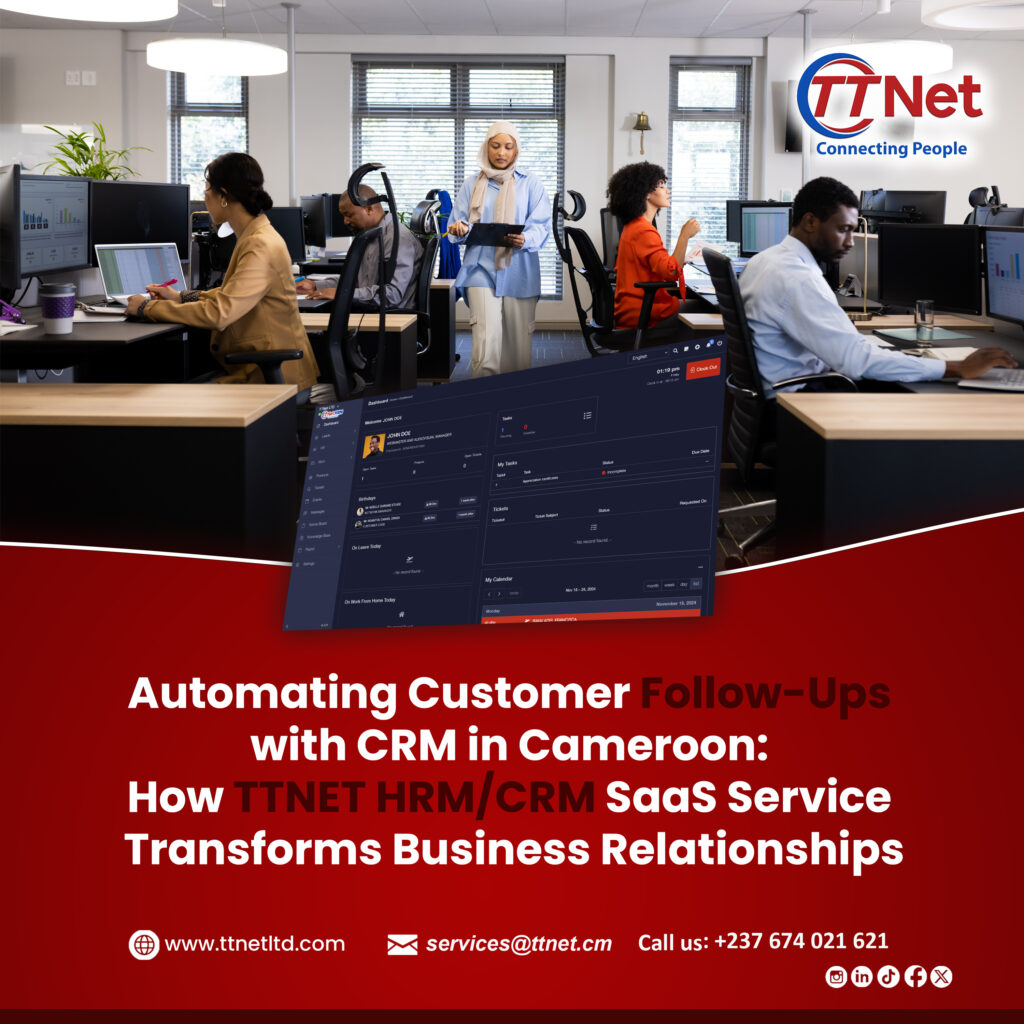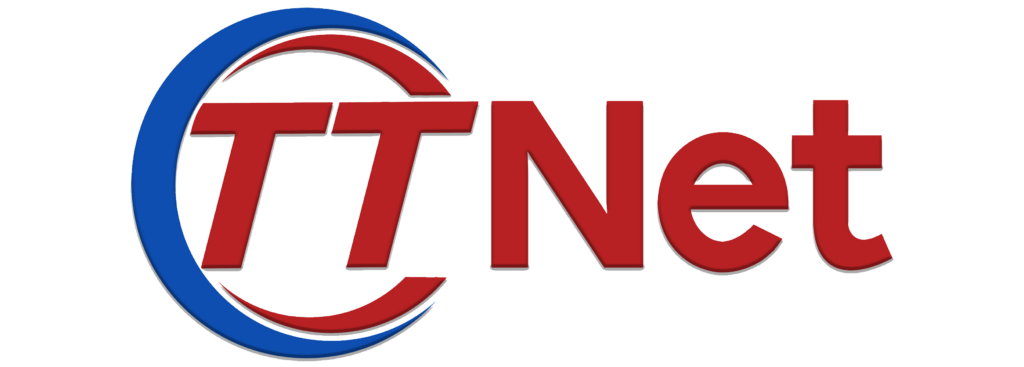
In Cameroon’s fast-evolving business landscape, customer retention is just as critical as acquisition. With rising competition across industries, from agriculture and manufacturing to fintech and retail, businesses are realizing that personalized, timely communication is key to building loyalty. However, manual customer follow-ups are time-consuming, error-prone, and difficult to scale. Enter Customer Relationship Management (CRM) systems, which automate and streamline these processes. For Cameroonian businesses, TTNET HRM/CRM SaaS Service offers a localized, cost-effective solution to revolutionize customer engagement.
In this blog post, we’ll explore:
1. Why customer follow-ups matter in Cameroon’s market.
2. Challenges businesses face with manual follow-up processes.
3. How CRM automation solves these challenges.
4. Features of TTNET HRM/CRM SaaS Service tailored for Cameroonian businesses.
5. Steps to implement CRM-driven follow-ups.
6. Real-world success stories and measurable outcomes.
Let’s dive in.
1. The Importance of Customer Follow-Ups in Cameroon
Cameroon’s economy is diverse, with SMEs contributing over 90% of businesses. Whether it’s a Douala-based agro-processing company, a Yaoundé tech startup, or a Bafoussam retail store, customer relationships determine long-term success. Here’s why follow-ups matter:
– Cultural Relevance: In Cameroon, trust is built through consistent communication. A missed follow-up can signal disinterest or unreliability.
– Competitive Edge: With similar products/services flooding markets, prompt follow-ups differentiate businesses.
– Revenue Growth: Returning customers spend 67% more than new ones (Bain & Company). Follow-ups nurture repeat purchases.
– Feedback Loop: Post-purchase check-ins help businesses refine offerings (e.g., tailoring mobile money services to rural needs).
Yet, many businesses rely on spreadsheets, handwritten notes, or memory to manage follow-ups, a system prone to inefficiencies.
2. Challenges of Manual Follow-Up Processes
a. Human Error and Inconsistency
Forgetfulness, misplaced notes, or miscommunication between teams lead to missed opportunities. A bakery in Bamenda might fail to remind loyal customers about a new bread variant, losing sales to competitors.
b. Time-Consuming Workflows
Manually tracking customer interactions (calls, emails, visits) steals time from revenue-generating activities. A Limbe-based logistics company spends hours weekly updating client records instead of optimizing deliveries.
c. Poor Scalability
As businesses grow, manual systems collapse under data volume. A Douala e-commerce startup scaling from 100 to 1,000 customers can’t maintain personalized follow-ups without automation.
d. Lack of Insights
Without analytics, businesses can’t measure follow-up success. How many leads converted after a follow-up call? Which customers are at risk of churning? Manual tracking provides no answers.
3. How CRM Automation Solves These Challenges
CRM systems centralize customer data, automate workflows, and provide actionable insights. Here’s how automation transforms follow-ups:
– Automated Reminders: Schedule calls, emails, or SMS based on triggers (e.g., post-purchase, subscription renewal).
– Personalization at Scale: Use customer data (purchase history, preferences) to tailor messages.
– Multi-Channel Integration: Engage customers via WhatsApp, email, SMS, or social media from one platform.
– Analytics: Track follow-up success rates, customer satisfaction, and ROI.
For Cameroonian businesses, adopting a CRM isn’t just about technology, it’s about aligning with global best practices while respecting local nuances.
4. TTNET HRM/CRM SaaS Service: Built for Cameroon’s Needs
TTNET, a leader in cloud-based enterprise solutions in Central Africa, offers an **HRM/CRM SaaS platform** designed for Cameroon’s unique challenges. Here’s how it stands out:
a. Affordable, Scalable Pricing
Many Cameroonian SMEs operate on tight budgets. TTNET’s subscription model offers tiered plans, allowing businesses to start small and scale as they grow.
b. Localized Support
TTNET provides customer service in French and English, with teams familiar with Cameroon’s regulatory and cultural landscape.
c. Key Features for Automated Follow-Ups
– Task Automation: Set reminders for follow-up calls, payment dues, or appointment confirmations.
– WhatsApp & SMS Integration: 85% of Cameroonians use mobile devices (ITU, 2022). TTNET enables bulk messaging via popular channels.
– Customer Segmentation: Group clients by location (urban vs. rural), industry, or purchase behavior for targeted follow-ups.
– Sales Pipeline Tracking: Monitor leads from initial contact to conversion, automating follow-ups at each stage.
– Reporting Dashboard: Generate real-time reports on follow-up performance, customer engagement, and sales trends.
d. Offline Accessibility
With inconsistent internet access in regions like Maroua or Bertoua, TTNET’s offline mode ensures data syncs once connectivity resumes.
e. HRM-CRM Integration
Sync customer follow-ups with staff performance metrics. For example, track how quickly your Yaoundé sales team responds to inquiries.
5. Implementing TTNET CRM for Automated Follow-Ups: A Step-by-Step Guide
Step 1: Define Follow-Up Goals
– What’s the objective? (e.g., reduce churn by 20%, boost repeat sales).
– Identify key touchpoints (post-purchase, subscription renewal, complaint resolution).
Step 2: Migrate Customer Data
Import existing spreadsheets or databases into TTNET CRM. Clean data to remove duplicates.
Step 3: Customize Workflows
– Set triggers: Automate a thank-you SMS after a purchase or a reminder email before a subscription lapses.
– Assign tasks to team members based on expertise (e.g., technical follow-ups to IT staff).
Step 4: Train Your Team
TTNET offers onboarding sessions to ensure staff can navigate dashboards, update records, and use analytics.
Step 5: Monitor and Optimize
Use TTNET’s analytics to refine follow-up strategies. For example, if SMS open rates are higher than emails, reallocate resources.
6. Overcoming Adoption Barriers in Cameroon
While CRM adoption is growing, some businesses hesitate due to:
– Cost Concerns: TTNET’s pay-as-you-grow model addresses this.
– Tech Literacy: User-friendly interfaces and training bridge knowledge gaps.
– Data Security: TTNET complies with Cameroon’s data protection laws, ensuring encrypted storage.
7. The Future of CRM in Cameroon
As smartphone penetration and digital literacy rise, CRM tools like TTNET will become indispensable. Future trends include:
– AI-Powered Insights: Predictive analytics to forecast customer needs.
– Voice Assistants: Follow-ups via voice calls in local languages (e.g., Ewondo or Fulfulde).
– E-Government Integration: Sync with tax or regulatory portals for compliance tracking.
Conclusion: Transform Your Follow-Ups with TTNET CRM
Automating customer follow-ups isn’t just a luxury, it’s a necessity for Cameroonian businesses aiming to thrive in a competitive market. TTNET HRM/CRM SaaS Service provides the tools to deliver timely, personalized engagement while saving time and reducing costs.
Ready to get started?
1. Visit [TTNET’s website](https://www.ttnetltd.com) for a free demo.
2. Join a webinar to see live CRM workflows.
Invest in CRM automation today, and watch your customer relationships, and revenue, grow tomorrow.
Call to Action:
Follow us on LinkedIn, Facebook, Instagram, or WhatsApp for tips on CRM best practices. Let TTNET help you turn every customer interaction into a lasting relationship!

